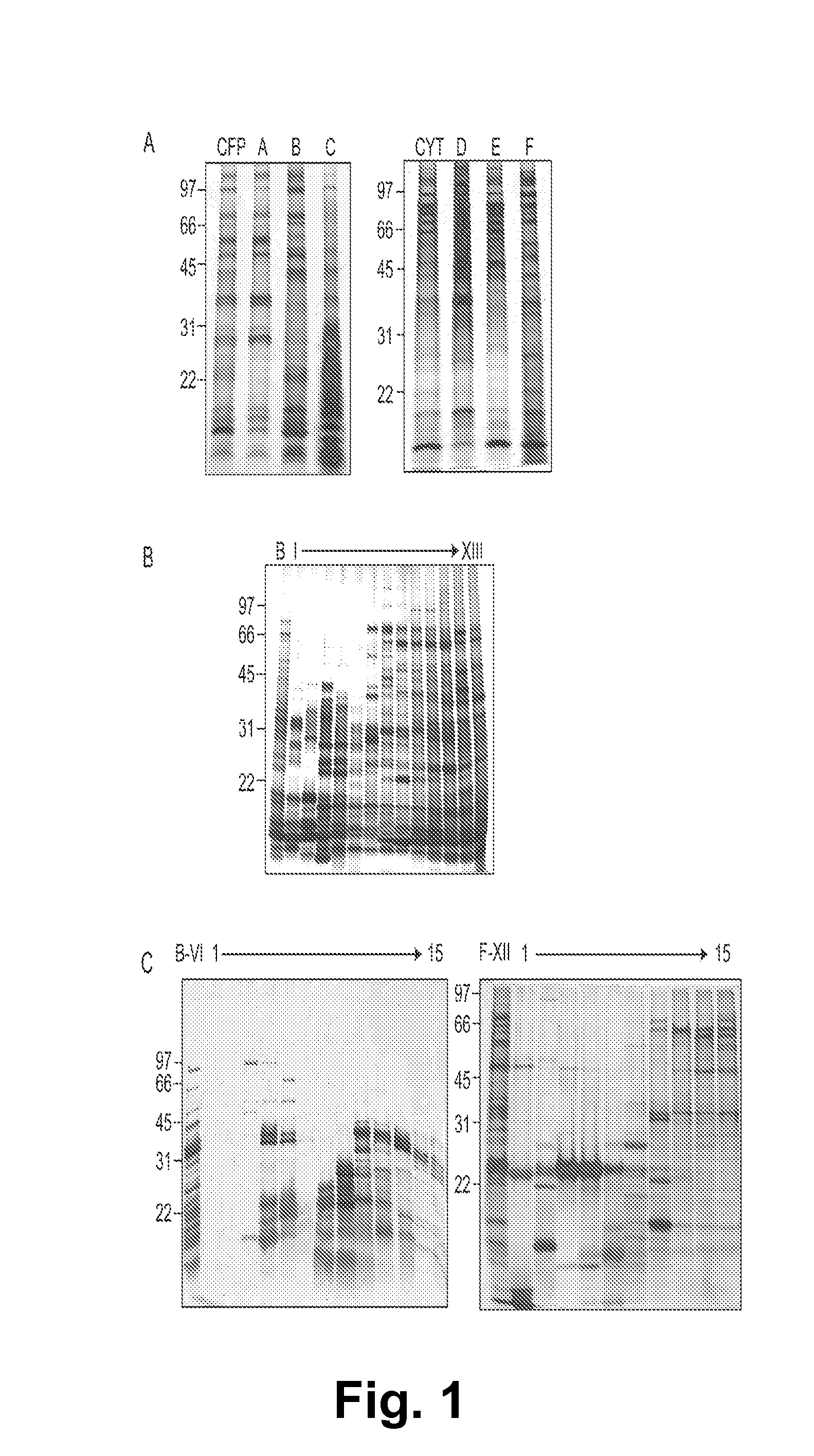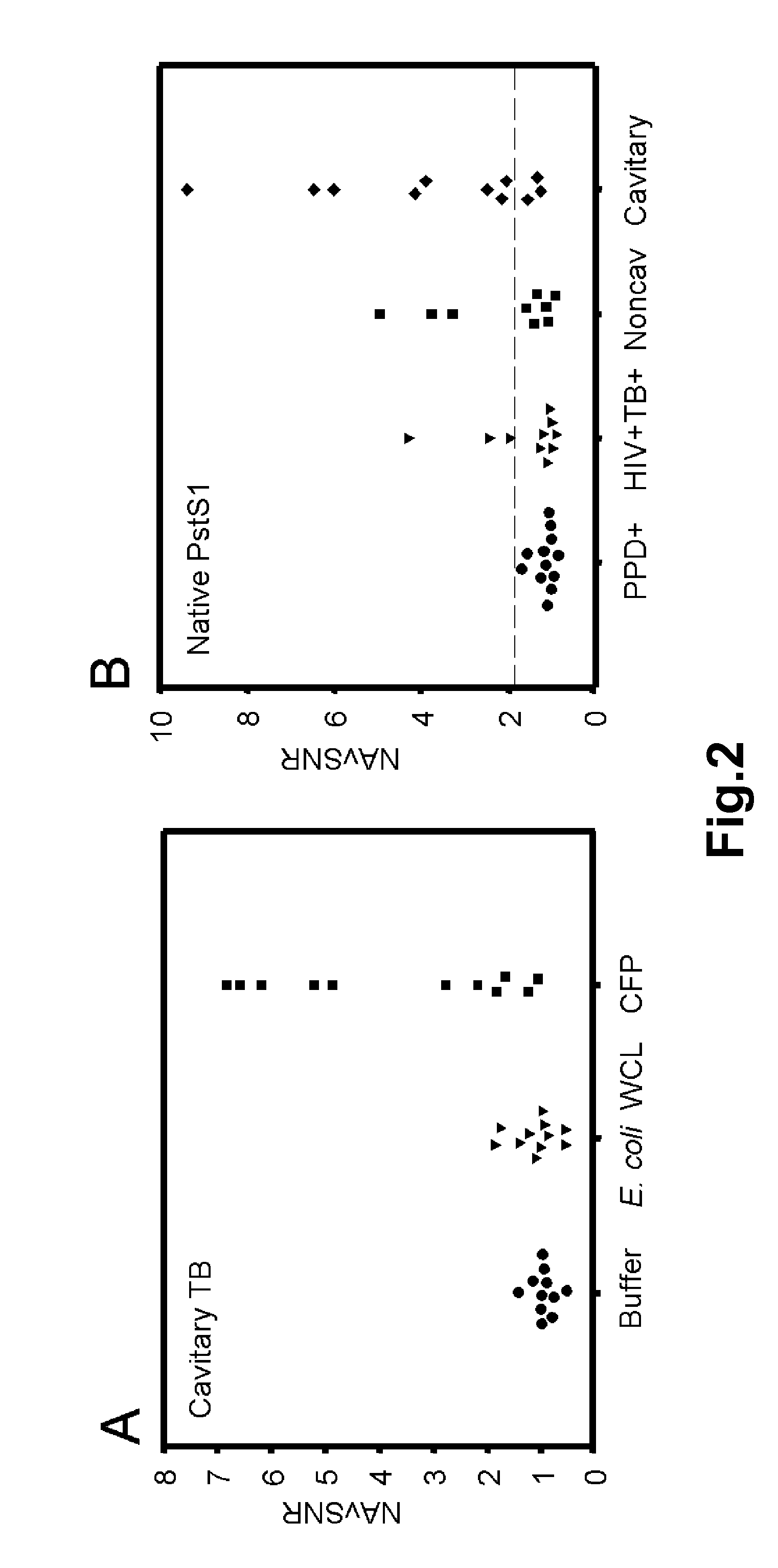Biomarkers of tuberculosis that distinguish disease categories: use as serodiagnostic antigens
a tuberculosis biomarker and disease category technology, applied in the field of microbiology, immunology and medicine, can solve the problems of difficult to complete the serological analysis of patients' serological reactivity to a large proportion of the i>mycobacterium tuberculosis /i>(mtb) proteome, difficult to achieve high-throughput testing, and easy to use methods
- Summary
- Abstract
- Description
- Claims
- Application Information
AI Technical Summary
Benefits of technology
Problems solved by technology
Method used
Image
Examples
example i
Experimental Procedures
Preparation of Mtb Subcellular Fractions
[0124]Mtb strain H37Rv was expanded from a 1-ml frozen stock (approximately 108 colony-forming units per ml) to 24 L of late log culture in glycerol-alanine salts medium (17). The culture supernatant was separated from the cells and processed to generate the CFPs of Mtb as previously described (18). The Mtb H37Rv cells (88.9 g wet weight) were washed 3 times with PBS (pH 7.4), frozen at −70° C. and inactivated with 24 kGy of γ-irradiation. Lysis of these cells was achieved by suspending in 44 ml of TSE buffer [10 mM Tris-HCl (pH 7.4), 150 mM NaCl, 1 mM EDTA] containing 0.06% DNase, 0.06% RNase, 0.07% pepstatin, 0.05% leupeptin and 20 μM PMSF and passing through a French Press five times at 1,500 psi. The resulting lysate was diluted with 1 vol of TSE buffer and centrifuged at 2,000×g for 5 min to remove unbroken cells. The cytosol was obtained as the final supernatant of sequential centrifugations at 27,000×g and 100,000...
example ii
Multi-Dimensional Protein Fractionation Reduced the Complexity of Mycobacterial Protein Pools
[0138]Recent advances in proteomics have enabled the separation and identification of individual proteins or peptides from complex biological samples. Specifically, multi-dimensional chromatography of peptides, derived from tryptic digests of crude biological samples, followed by MS / MS analysis (“MudPIT”) has provided experimental validation of substantial portions of theoretical proteomes (25). Recently, this approach was applied to Mtb and resulted in more than a threefold increase in the number of proteins that had previously been identified by 2-D gel electrophoresis methods (26).
[0139]Applying a similar strategy, the present study employed a multi-dimensional fractionation scheme (FIG. 6) for efficient separation of complex pools of intact Mtb proteins into relatively simple and enriched fractions that could be evaluated for serological reactivity in a high-throughput fashion.
[0140]Aliq...
example iii
Validation of the Protein Microarray Format
[0141]Each multidimensional chromatography fraction, as well as intermediate fractions and recombinant proteins were printed to nitrocellulose microarray slides. Serum samples from PPD+ healthy subjects (n=12), noncavitary-TB subjects (n=9), cavitary-TB subjects (n=11), and HIV+TB+ (n=10) subjects were probed against the microarrays in triplicate. For each slide the NAvSNR (see Example I) was calculated for each protein or protein fraction. The integrity of the protein microarray and validation of this platform was determined by assessing the reactivity of TB patients' sera with selected protein fractions and with purified proteins that were spotted on the microarray slides as controls, and comparing these results to published results obtained by plate ELISA (5, 6).
[0142]To demonstrate specificity, the reactivity of TB patients' serum samples towards unfractionated CFP was compared to reactivity towards either E. coli WCL control or FAST® p...
PUM
| Property | Measurement | Unit |
|---|---|---|
| reactivity | aaaaa | aaaaa |
| serological reactivity | aaaaa | aaaaa |
| signal-to- | aaaaa | aaaaa |
Abstract
Description
Claims
Application Information
 Login to View More
Login to View More - R&D
- Intellectual Property
- Life Sciences
- Materials
- Tech Scout
- Unparalleled Data Quality
- Higher Quality Content
- 60% Fewer Hallucinations
Browse by: Latest US Patents, China's latest patents, Technical Efficacy Thesaurus, Application Domain, Technology Topic, Popular Technical Reports.
© 2025 PatSnap. All rights reserved.Legal|Privacy policy|Modern Slavery Act Transparency Statement|Sitemap|About US| Contact US: help@patsnap.com



